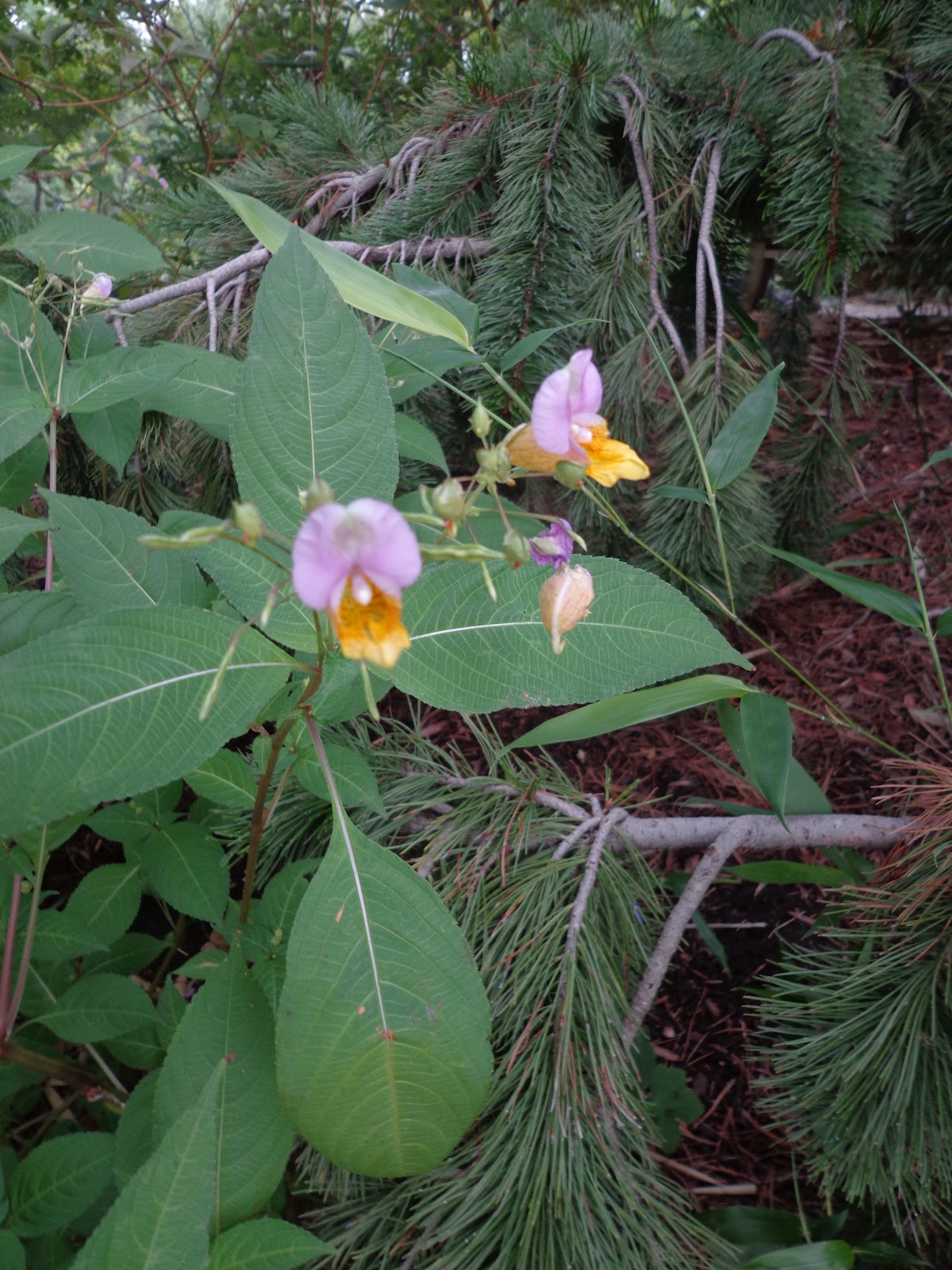 |
| Impatiens bicolor (closeup) |
This time of year, gardeners get might "impatient"--so what better post on a Valentine's day than these wonderful summer delights (with their somewhat heart shaped flowers and buds)... I doubt you have seen this one before--Dan Johnson and I collected seed of it in September of 2001 (yes--not long after the infamous 9-11-2001) in the Himalayas of Pakistan. I don't recall seeing this offered by any company--we may have indeed introduced it to cultivation subsequently. Like all impatiens, it is prollific and explosive in its seeding--so we have been a tad cautious about sharing it. But it has shared itself generously at Denver Botanic Gardens and a few local gardens as well...
I am a bit surprised the botanist only thought it had "bi" colors--I see white, yellow and pink. Like others of its clan, it likes shade and not too dry a spot--although Pakistan being at the dry end of the Himalaya this is not as fussy as the gigantic sorts that are such weeds in England and the Pacific Northwest.
 |
| Impatiens biclor |
Another view of our Pakistani...which admitedly looks an awful lot like the other compact impatiens that is often grown (although compact is relative--this can get a meter tall in a moist enough spot)...
 |
| Impatiens balfourii |
Impatiens balfourii is much more bi-colored than its more westerly occuring cousin. It is every bit as vigorous--my original plantings have spread far beyond their allotted space in the Rock Alpine Garden, and now it's busy gobbling up Woodland Mosaic: the flowers are truly ethereal, and the plant is really pretty manageable. I've had far more trouble when I grew our native Touch-me-not (which is locally common in the Denver-Boulder area along some piedmont streams): our orange and yellow native spread everywhere and the seedlings seemed to mature in no time flat!
This year perhaps I will finally obtain the brilliant new Blue Tibetan impatiens that is offered by Annie's Annuals (I shan't tell you the name lest you buy the last ones), and maybe I can persuade Impatiens omeiana to actually grow well enough to overwinter.
Perhaps you can solve a mystery: early in my career a neighbor who lived near Colfax invited me to a garden party "I have a pretty garden, you must see it: it's full of little orchids"--well--who would resist attending a nearby party where the garden is "full of little orchids!"...there were lots of neighbors there that afternoon and some good party snacks--the orchids were out back she told me. So I sidled my way through the munching crowd, and walked into an enchanted little back garden with hostas and other pleasant shady things. No orchids in sight, but dozens of diminutive impatiens--half the size or less than the two I've described, with even more spritely bright rose and white flowers with a sort of monkey like face. I stupidly didn't ask for seed--and I am still wondering what they might have been. This was 30 years ago--the lady was elderly then. But the house still stands just a few blooks from work. This year, I must go see if any of the "little orchids" persisted. What the heck could they have been?




Seeds purloined from Dan' garden and carried home in my pocket, Impatiens bicolor now covers more than 400 sq. ft. of garden space. It's a welcome addition and pulls easily where I do not want it (for that year). I agree, it should be called I. tricolor.
ReplyDeleteJ. Borland
Panayoti,
ReplyDeleteIs the mystery impatien the old fashion garden annual called Balsam?
I have seen jewelweed or Spotted Touch-me-not seedling growing on dry gravel hill prairies in spring. I asked how they managed to arrive in the location and was told the seeds arrived by bird droppings. That explained why the seedling all grew in little patches. The seedlings did not have a chance on this dry gravel hill prairie once the spring moisture was cooked away.
You better be careful with that Impatien balfourii. You might have the weed police knocking on your door.
James
I'm gonna tell Dan on you, Jim! And, James, at first I thought your suggestion of Impatiens balsamina was wrong--but when I looked it up I realized that some did look a bit like her plant. It is very possible that she grew it long enough that a uniform, wild-like strain developed from her cultivated plants. What I remember surely did not resemble the double flowered mostruouse foms I usualloy associate with this poor plant, but the single flowered ones are rather charming. I must add it to my list!
DeleteHey no-name. That be Himalayan Balsam alright - that last one. I had it here in France but it got too succesful so I'm in a two year process of thwarting it. Beautiful plants all the same.
ReplyDeletePanayoti,
ReplyDeleteHave you heard about powdery mildew taking a massive toll on Impatiens? I just read a blog on Garden Rant about it. Any suggestions?
Will this self-pollinate?
ReplyDeleteI have just seen the note from Frank Car: I believe it will self pollinate. And Mark, I think the only solution is not to grow the Impatients that are subject to the mildew.
ReplyDeleteThank you! Imaptiens bicolor now covers an entire subwatershed in Portland Oregon, is taking gallons of herbicide and days of staff time to control, and is still spreading! We can add this to the other invasive impatiens folks all around the Pac NW spend time and resources controlling.
ReplyDelete